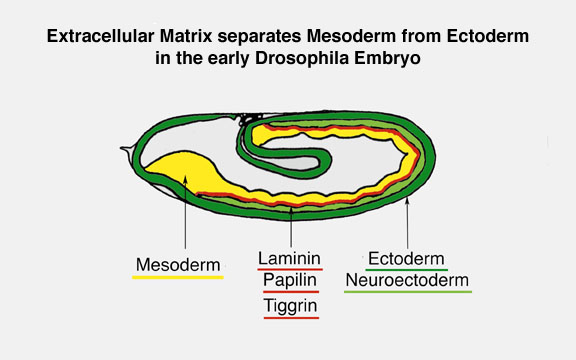Developmental molecular biology of cell-matrix interactions.
We are investigating how differentiating embryonic cells cooperate to synthesize their immediately adjacent macromolecular environment and then interact with it during development. Specifically, we are learning how Drosophila basement membranes arise and function. These thin, macromolecular nets are essential for the differentiated state of epithelia, muscles and nerves, and have been conserved during evolution in man and Drosophila. We isolate and characterize the corresponding Drosophila proteins and genes, and study their expression during development.
Key molecules that we are currently studying are Tiggrin, Papilin and Peroxidasin. We discovered and characterized each by protein isolation and nucleic acid sequencing.
Tiggrin has a novel protein structure and is a ligand for an integrin cell surface receptor on muscles. We are studying its formation and signaling through integrins between the inside and outside of cells during development.
Papilin appears with another protein, laminin, at tissue interfaces during early mesoderm formation (shown diagrammatically in the figure). During later embryonic development both glycoproteins become components of basement membranes. We are investigating whether papilin modulates interactions between adjacent cells during differentiation.
Peroxidasin is an unexpected molecular hybrid between an enzyme and an extracellular matrix connective tissue protein. Its remarkable conservation across a broad species spectrum suggests one or more conserved functions. Peroxidasin is made by phagocytic hemocytes that remove cells that have undergone programmed cell death. Peroxidasin may also cross-link proteins. We are searching for potential roles of peroxidasin in fundamental defense and/or matrix construction paradigms.
